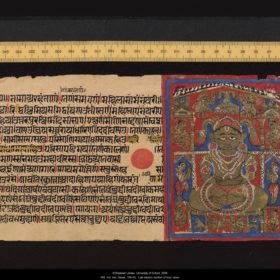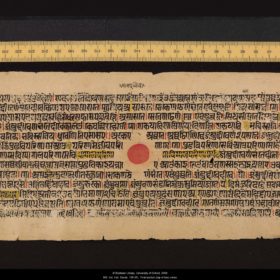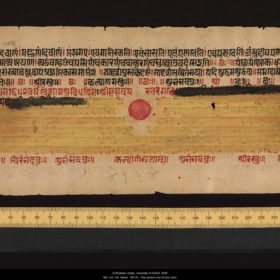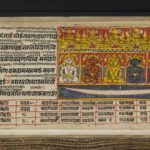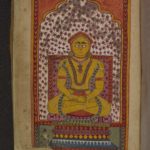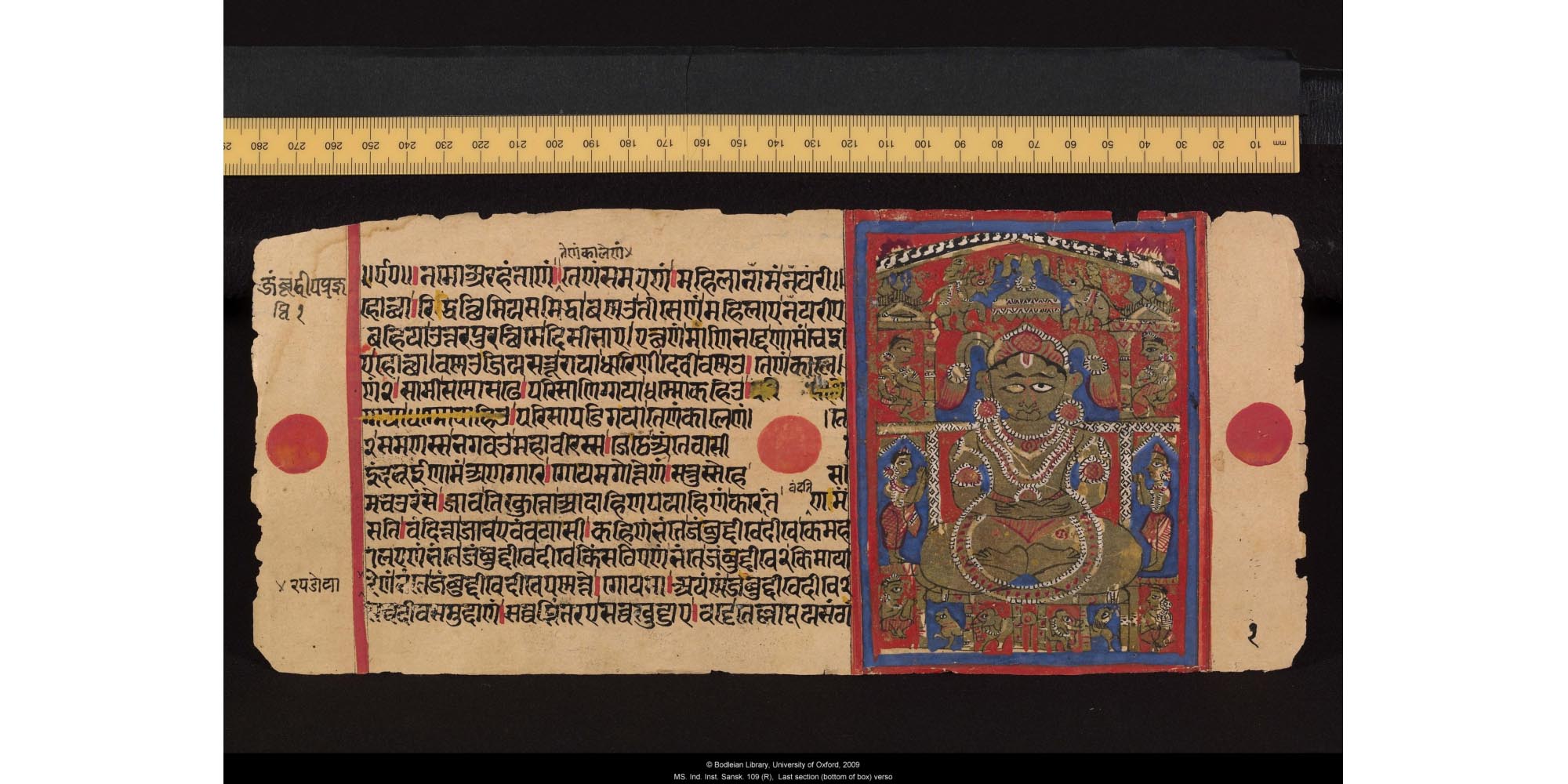
Background
The Jambū-dvīpa-prajñapti is part of the Śvetāmbara canon. It belongs to the second group, the Upāngas, of which it is the sixth. Like all the texts belonging to the Śvetāmbara canon, its language is the variety of Prakrit known as Ardhamāgadhī.
The Jambū-dvīpa-prajñapti deals with the description and geography of the Jambū-dvīpa, which is the central continent of the Jain universe. The main part of the work deals with the seven lands and the six mountain chains that make up Jambū-dvīpa.
Among these lands, Bharata is the main focus of attention. The land is named after its ruler, the first Universal Emperor Bharata. The text gives an important place to legends connected with the life of Ṛṣabhanātha or Lord Ṛṣabha, the first Jina, and his eldest son Bharata. It also provides information about the divisions, mountains, lakes and rivers of the Jambū-dvīpa. Matters of time, which are inseparable from cosmology, are covered in the final part of the work.
Glossary
Description
Bedecked in jewellery, a very large figure wearing a kind of tilaka on his forehead sits in the lotus position under an arch. Either side of him are smaller figures raising their hands. Along the borders of the picture are numerous smaller figures.
This is the standard representation of a Jina in the heaven where he is reborn before his final incarnation on earth. In that final life on earth, he reaches omniscience and becomes a Jina.
The Jina is shown sitting in meditation posture on a throne inside a pavilion. He is flanked by attendants with hands upraised in a gesture of respect.
The smallest figures are musicians and dancers. The long protruding eye is a typical feature of Western Indian painting. Its origin is unclear.
Note the wealth of ornamentation in the background.
Here the Jina cannot be identified without an emblem. However, if the small figure at the bottom left is a lion, that points to the 24th Jina, Mahāvīra. Even without it, it is likely that the Jina shown here is indeed Mahāvīra, because he is considered the ultimate source of teaching.
On this page, the representation of a Jina has no specific relationship with a story or the text beside it. Even when a manuscript is otherwise not illustrated, as with this one, the image of a Jina, Mahāvīra, is frequently found at the beginning. Picturing a Jina gives an auspicious start to a manuscript.
Other visual elements
There are several notable things about this page, namely:
- the original paper is slightly torn at the edges and has water stains in the upper-left corner
- the bottom of the right margin contains the number 1, which is the folio number
- at the top of the left-hand margin is Jambūdvīpa° sūtra 1, which is the abbreviated title of the work Jambū-dvīpa-prajñapti, along with the folio number, which therefore occurs twice on the page
- at the very beginning of line 1, between vertical lines, is an auspicious symbol known as bhale, often used at the start of a manuscript
- following the auspicious symbol is the phrase namo arahaṃtāṇaṃ – 'Homage to the Arhats' – which is the first part of the Pañca-namaskāra-mantra, the foremost Jain holy formula, which is written or recited before any text or ceremony
- above line 1, in the left-hand margin by line 12 and below the central red circle are words the scribe originally missed out that have been added by a later reader
- yellow pigment is used as an eraser.
The three circles along the central horizontal plane are symbolic reminders of the way in which manuscripts were bound when they were on palm leaf. Strings through holes in the paper were used to thread together the loose folios so the reader could turn them over easily. The circles are in the places where the holes would once have been.
Script
The elaborate script is the Jaina Devanāgarī script, in a form which recalls calligraphy. It is used for writing many Indian languages, here for Prakrit.
There are a few notable features of this script, namely:
- it is an old type in the way the sounds e and o are notated when used with a consonant, known as pṛṣṭhamātrā script
- the red vertical lines within the text, which, though they are used to divide the long sentences into smaller parts, are not necessarily punctuation marks.
Summary of the text
The text next to the image provides the general framework for the main narrative, and can be summarised as follows:
- There was a city named Mithilā – Mahilā – line 1
- To the north-east of this city there was a sacred enclosure, named Maṇibhadda – lines 3 to 4
- The king was called Jitaśatru and the queen Dhāriṇī – line 4
- At this time, Lord Mahāvīra held a general assembly and preached. The king and his entourage attended this sermon then went back to the palace – lines 4 to 5
- On this occasion, Mahāvīra's head disciple, Indrabhūti Gautama, paid his respects to his teacher and asked him: 'Where is Jambū-dvīpa? How large is it? Of what parts is it composed?' – lines 9 to 11
- Then Mahāvīra started to discuss Jambū-dvīpa
- Source:
Bodleian Libraries, University of Oxford
- Shelfmark:
MS. Ind. Inst. Sansk. 109
- Author:
unknown
- Date of creation:
1596
- Folio number:
1 verso
- Total number of folios:
116
- Place of creation:
western India
- Language:
Ardhamāgadhī Prākrit
- Medium:
watercolour on paper
- Size:
28 x 13 cms
- Copyright:
Bodleian Libraries, University of Oxford
- Image Copyright:
- +
- aAbhavya
- aAbhinandana
- aAbhiṣeka
- aĀcāra
- aĀcārāṅga-sūtra
- aĀcārya
- aAchalbhrata
- aAḍhāī-dvīpa
- aAdharma
- aAdho-loka
- aAdhyayana
- aAdvaita Vedānta
- aĀgama
- aAghātīya
- aAghātīya-karman
- aAgnibhuti
- aAgra
- aĀhāra
- aAhiṃsā
- aAhimsa Day
- aAjita
- aAjīva
- aAkampit
- aĀkāśa
- aAkbar the Great
- aAkṣaya-tṛtīyā
- aAlauddin Khalji
- aAlbert Einstein
- aAllah
- aAlms
- aĀlocanā
- aAloka-ākāśa
- aAmāri
- aAmbikā or Kūṣmāṇḍinī
- aAnagāra
- aAnanta
- aAnarthadaṇḍa
- aAnaśana
- aAnekānta-vāda
- aAṅga
- aAniconism
- aAnojjā
- aAntarāla
- aAntarāya-karma
- aAṇu
- aAṇu-vrata
- aAnukampā
- aAnuprekṣā
- aAnusvāra
- aApabhraṃśa
- aAparigraha
- aAra
- aĀrambha
- aĀrambhaja
- aĀratī
- aArdhamāgadhī Prākrit
- aArhaṃ
- aArhat
- aArśana-āvaraṇīya-karma
- aĀrta-dhyāna
- aĀryikā
- aĀryikā Jñānamati
- aĀśātanā
- aĀścarya
- aAscetic
- aAsceticism
- aAshram
- aAspiration
- aĀsrava
- aAṣṭa-maṅgala
- aAṣṭāpada
- aAstikāya
- aAstrolabe
- aAsura
- aAtheism
- aAticāra
- aAtiśayakṣetra
- aAtithisaṃvibhāgavrata
- aĀtma-vāda
- aĀtman
- aAuṃ
- aAurangzeb
- aAuspicious
- aAusterity
- aAvadhāna
- aAvadhi-jñāna
- aĀvaraṇī-yakarman
- aAvasarpiṇī
- aAvatāra
- aAvidyā
- aAxiom
- aĀyāga-paṭa
- aĀyambil
- aĀyu-karma
- aĀyurveda
- bBabur
- bBāhubali
- bBaladeva
- bBālāvabodha
- bBandha
- bBasadi
- bBazaar
- bBhadrankarvijay
- bBhagavant
- bBhaktāmara-stotra
- bBhakti
- bBhale
- bBharata
- bBhāṣā
- bBhāṣya
- bBhaṭṭāraka
- bBhāva
- bBhāva-pūjā
- bBhāvanā
- bBhavana-vāsin
- bBhavya
- bBhavyatva
- bBhaya
- bBhoga-bhūmi
- bBhogopabhoga
- bBodhi
- bBollywood
- bBrahmā
- bBrahma-deva
- bBrahmacārī
- bBrāhmaṇa
- bBraj Bhāṣā
- bBright fortnight
- bBritish Raj
- bBuddha
- bBuddhi-sagar
- bBuddhism
- bBuddhist
- cCaitya
- cCaityavāsin
- cCakravartin
- cCakreśvarī
- cCāmara
- cCandanā
- cCandragupta
- cCandraprabha
- cCanon
- cCāritra
- cCāritramohanīya-karman
- cCarũrī
- cCaste
- cCaturvidha-saṅgha
- cCaturviṃśati-stava
- cCāturyāma
- cCE
- cCelibacy
- cCha
- cChadmastha
- cChastity
- cCheda-sūtra
- cChristian
- cChristianity
- cClergy
- cCloning
- cColophon
- cCommentary
- cConch
- cConfession
- cCongregation
- cConsecration
- cCosmology
- cCremation
- cCrore
- cCult
- cCūrṇi
- dDādā-guru
- dDalit
- dDāna
- dDaṇḍa
- dDark fortnight
- dDarśana
- dDarśanamohanī-yakarman
- dDaśa-lakṣaṇa-parvan
- dDeity
- dDelhi Sultanate
- dDerāsar
- dDeśāvakāśika-vrata
- dDetachment
- dDevanāgarī
- dDevānandā
- dDevarddhi-gani
- dDevotee
- dDhamal
- dDhanuṣ
- dDhāra
- dDharma
- dDharma-dhyāna
- dDharma-sāgara
- dDharmastikaya
- dDhātakīkhaṇḍa
- dDholak
- dDhyāna
- dDiaspora
- dDig-vrata
- dDigambara
- dDīkṣā
- dDisciple
- dDīvālī
- dDivya-dhvani
- dDNA
- dDoctrine
- dDogma
- dDonor
- dDoṣa
- dDravya
- dDravya-pūjā
- dDrone
- dDuṣamā
- dDuṣamā-duṣamā
- dDuṣamā-suṣamā
- dDveṣa
- dDvīpa
- eEast India Company
- eEightfold Path
- eEkānta-vāda
- eEkendriya
- eElder
- eElders
- eEschatology
- eEtc up to
- fFarmān
- fFast
- fFatehpur Sikri
- fFestival
- fFestschrift
- fFiruz Shah
- fFly-Whisks
- fFolio
- fFour Noble Truths
- gGaccha
- gGaṇa
- gGaṇadhara
- gGanadharavada
- gGaṇeśa
- gGaṇin
- gGarba
- gGarbha
- gGarbha-gṛha
- gGaruḍa
- gGati
- gGene
- gGenomics
- gGhātī-yakarman
- gGhātīya
- gGhaznavid
- gGhiyasuddin Tughlaq
- gGhurid
- gGloss
- gGotra-karma
- gGujarāt
- gGujarati
- gGuṇa
- gGuṇa-sthāna
- gGuṇa-vrata
- gGupti
- gGuru
- gGuruṇī
- hHagiography
- hHajj
- hHaṃsa
- hHaribhadra
- hHariṇaigameṣin
- hHasta
- hHeresy
- hHiṃsā
- hHindi
- hHindu
- hHinduism
- hHīravijaya
- hHoroscope
- hHrīṃ
- hHumayun
- hHymn
- iIconoclasm
- iIconography
- iIdol
- iIndian Independence
- iIndology
- iIndra
- iIndrabhūti Gautama
- iIndriya
- iInitiation
- iIntercession
- iInvocation
- iIQ
- iIslam
- iIslamicate
- iIṣṭadevatā
- iĪśvara
- jJagat
- jJahangir
- jJain
- jJaina Devanāgarī
- jJaina Śaurasenī
- jJaina-dharma
- jJainaśāsana
- jJainness
- jJaisalmer
- jJamāli
- jJambū-dvīpa
- jJames Burgess
- jJanma
- jJanma-kalyāṇa
- jJarā
- jJāti
- jJina
- jJina-āgama
- jJina-bhavana
- jJina-bimba
- jJina-mātā
- jJinacandra-sūri
- jJinadatta
- jJinaprabha
- jJīva
- jJñāna
- jJñāna-āvaraṇīya-karma
- jJñāna-āvarṇiya
- jJñānsundar
- jJyotiṣka
- kKāla
- kKālakācārya-kathā
- kKālidāsa
- kKalpa-sūtra
- kKalpa-vṛkṣa
- kKalyāṇaka
- kKalyanvijay
- kKamaṇḍalu
- kKamaṭha
- kKarma
- kKarma-bhūmi
- kKarma-grantha
- kKarma-prakṛti
- kKarma-vāda
- kKarmon
- kKarnataka
- kKaṣāya
- kKathā
- kKāvya
- kKāya
- kKāyotsarga
- kKeśa-loca
- kKetu
- kKevala-jñāna
- kKevalin
- kKhalji
- kKharatara-gaccha
- kKnowledge
- kKriyā
- kKriyā-vāda
- kKṛṣṇa
- kKṣamā-śramaṇa
- kKṣapakaśreṇi
- kKṣatriya
- kKṣullaka
- kKulakara
- kKundakunda
- kKunthu
- lLabdhi
- lLaity
- lLakh
- lLāñchana
- lLands of Action
- lLaukāntika
- lLavaṇa-samudra
- lLeśyā
- lLiṅga
- lLinguistics
- lLoka
- lLoka-ākāśa
- lLoka-puruṣa
- lLoka-vāda
- lLotus
- lLotus lake
- mMadhya-loka
- mMahā-videha
- mMahā-vrata
- mMahābhārata
- mMahāmastakābhiṣeka
- mMāhārāṣṭra
- mMāhārāṣṭrī Prākrit
- mMahattarā Yākinī
- mMahāvīr Jayantī
- mMahāvīra
- mMakāra
- mMakkhali Gośāla
- mMalli
- mMāna-stambha
- mManaḥ-paryāya-jñāna
- mMaṇḍala
- mMaṇḍapa
- mMandit
- mMaṅgala
- mMantra
- mMantras
- mManuṣya-loka
- mMarāṭhī
- mMārgaṇā
- mMartyr
- mMarudevī
- mMaṭha
- mMati-jñāna
- mMauryaputra
- mMecca
- mMendicant lineage
- mMetarya
- mMiracle
- mMithyādṛṣṭi
- mMohandas Gandhi
- mMohanīya-karma
- mMokṣa
- mMonastic order
- mMonasticism
- mMonk
- mMonotheism
- mMosque
- mMount Meru
- mMount Sammeta
- mMṛgāvatī
- mMughal
- mMuhammad
- mMuhammad bin Tughlaq
- mMuhpattī
- mMūla-sūtra
- mMūlaguṇa
- mMumbaī
- mMuni
- mMunisuvrata
- mMurad Bakhsh
- mMūrti-pūjaka
- mMuslim
- mMysticism
- nNābhi
- nNāga-kal
- nNāgapurīya Tapā-gaccha
- nNāgarī
- nNāma-karma
- nNamaskāra-mantra
- nNami
- nNandīśvara-dvīpa
- nNandivardhana
- nNandyāvarta
- nNāraka
- nNāraki
- nNasalisation
- nNātha
- nNavrātrī
- nNaya-vāda
- nNemi
- nNidāna
- nniggaṃthāṇa vā 2
- nniggaṃtho vā 2
- nNigoda
- nNihnava
- nNikṣepa
- nNirgrantha
- nNirjarā
- nNirvāṇa
- nNiryukti
- nNiṣidhi
- nNitya
- nNiyati
- nNo-kaṣāya
- nNudity
- nNun
- oOcean of milk
- oOmniscience
- oOrdination
- ppa°
- pPadmaprabha
- pPadmāsana
- pPadmāvatī
- pPādukā
- pPalanquin
- pPalette
- pPañca-muṣṭi
- pPāṇḍava
- pPaṇḍit
- pPandit Dalsukh D. Malvania
- pPandit Sukhlalji
- pPāṇipātra
- pPāpa
- pParamātman
- pParameṣṭhin
- pPāraṇā
- pParigraha
- pPariṇāma
- pParīṣaha
- pParokṣa
- pPārśva
- pPārśvanātha
- pParyāya
- pParyuṣaṇ
- pPaṭa
- pPatan
- pPātra
- pPenance
- pPersian
- pPhala
- pPhilology
- pPicchikā
- pPilgrimage
- pPīr
- pPolymath
- pPoṣadha
- pPossession
- pPothī
- pPrabhas
- pPradakṣiṇā
- pPradeśa
- pPrākāra
- pPrakīrṇaka-sūtra
- pPrākrit
- pPramāda
- pPramukhā
- pPrati-vāsudeva
- pPratikramaṇa
- pPratimā
- pPratiṣṭhā
- pPratyākhyāna
- pPratyakṣa
- pPravacana
- pPrāyaścitta
- pPrayer
- pPre-modern
- pPreach
- pPredestination
- pProtestant
- pProvenance
- pPudgala
- pPūjā
- pPujārī
- pPukharavara-dvīpa
- pPuṇya
- pPūrva
- pPuṣkara-dvīpa
- pPuṣpadanta
- pPyre
- qQur’an
- rRāga
- rRāhu
- rRainy season
- rRajasthan
- rRajasthani
- rRājimatī
- rRajoharaṇa
- rRajput
- rRāma
- rRāmāyaṇa
- rRangoli
- rRās-garbā
- rRasa
- rRathanemi
- rRatna-traya
- rRātri-bhojana
- rRaudra-dhyāna
- rRecto
- rRelic
- rRenunciation
- rRetroflex
- rRevatī
- %Ṛg-veda
- rRite
- rRosary
- %Ṛṣabha
- %Ṛṣabhanātha
- rRupee
- sSaciyā Mātā
- sSādhu
- sSādhvī
- sSāgāra
- sSaint
- sŚaivaism
- sŚaka-saṃvat
- sSallekhanā
- sŚalya
- sSamacatuṣṭha
- sSamādhimaraṇa
- sSamaṇi
- sSāmarambha
- sSamavasaraṇa
- sSāmāyika
- sSaṃbhava
- sSamiti
- sSaṃjñā
- sSaṃkalpaja
- sSaṃsāra
- sSamudghāta
- sSaṃvara
- sSaṃvega
- sSamyak-cāritra
- sSamyak-darśana
- sSamyak-jñāna
- sSamyaktva
- sSaṃyama
- sSanctuary
- sSandalwood
- sSaṇgha
- sSanskrit
- sSant
- sŚānti
- sSapta-bhaṅgi-naya
- sSārambha
- sSarasvatī
- sSarvajña
- sSāsan-devi
- sŚāsana-devatā
- sŚāstra
- %Ṣaṭ-jīvanikāya
- sSatī
- sSatīmātā
- sSatya
- sSchism
- sScribe
- sScripture
- sSect
- sSecularism
- sŚenāī
- sSermon
- sŚeṣavatī
- sSevā
- sSeven fields of donation
- sShah Jahan
- sShantidas Jhaveri
- sShrine
- sSiddha
- sSiddha-śilā
- sSiddhacakra or Navadevatā
- sSiddhānta
- sSiddhārtha
- sSiddhi
- sSikh
- sSikhism
- sŚikṣā-vrata
- sŚīla
- sSin
- sSindh
- sŚītala
- sŚiva
- sSkandha
- sSomanatha
- sŚraddhā
- sŚramaṇa
- sŚrāvaka
- sŚrāvakācāra
- sŚrāvikā
- sŚreyāṃsa
- sŚrī
- sŚrīvatsa
- sŚruta-jñāna
- sŚruta-pañcamī
- sSthānaka-vāsin
- sSthāpanācārya
- sSthāvara
- sSthavira
- sSthiti
- sStrīmukti
- sStūpa
- sSubcontinent
- sSudarshana
- sŚuddhi
- sSudharma
- sŚūdra
- sSufism
- sSukha
- sŚukla-dhyāna
- sSulasā
- sSultan
- sSumati
- sSundarśrī
- sSupārśva
- sSūri
- sSuṣamā
- sSuṣamā-duṣamā
- sSuṣamā-suṣamā
- sSūtra
- sSuyam me ausam! Tenam bhagavaya evamakkhayam
- sSvādhyāya
- sSvāhā
- sSvastika
- sŚvetāmbara
- sŚvetāmbara Terāpanthin
- sŚvetāmbaras
- sSwan
- sSyād-vāda
- tTabla
- tTantra
- tTapā-gaccha
- tTapas
- tTāraṇ Svāmī Panth
- tTattva
- tTattvārtha-sūtra
- tTemple
- tTemple-city
- tThe Enlightenment
- tTheology
- tThree worlds
- %Ṭīkā
- tTilaka
- tTīrtha
- tTīrthaṃkaranāma-karman
- tTīrthankara
- tTransliteration
- tTrasa
- tTrasa-nāḍī
- tTriśalā
- tTriṣaṣṭi-śalākā-puruṣa-caritra
- tTti bemi
- tTughlaq
- tTunk
- uUdumbara
- uUniversal History
- uUpādhyāya
- uUpāṅga
- uUpaniṣads
- uUpāsaka
- uUpasarga
- uUpāśraya
- uŪrdhva-loka
- uUtsarpiṇī
- uUttarādhyayana-sūtra
- vVāhana
- vVaimānika
- vVairāgya
- vVaiṣṇava
- vVaiśramaṇa
- vVaiśya
- vValabhī
- vVanaspatikāya
- vVandana
- vVaṇik
- vVarṇa
- vVāsudeva
- vVāsupūjya
- vVayubhūti
- vVeda
- vVedanīya-karma
- vVegetarianism
- vVehicle
- vVernacular
- vVerso
- vVidyā
- vVidyā-devī
- vVihāra
- vVijñapti-patra
- vVikrama-saṃvat
- vVikṛti
- vVimala
- vVinaya
- vVipāka
- vVirji Vora
- vVirodhaja
- vVīrya
- vVisarga
- vViṣṇu
- vVītarāga
- vVizier
- vVotive
- vVow
- vVrata
- vVS
- vVyakta
- vVyantara
- vVyasana
- yYakṣa
- yYakṣī
- yYantra
- yYaśoda
- yYaśovijaya
- yYati
- yYātrā
- yYoga
- yYoginī
- yYojana
Description
Bedecked in jewellery, a very large figure wearing a kind of tilaka on his forehead sits in the lotus position under an arch. Either side of him are smaller figures raising their hands. Along the borders of the picture are numerous smaller figures.
This is the standard representation of a Jina in the heaven where he is reborn before his final incarnation on earth. In that final life on earth, he reaches omniscience and becomes a Jina.
The Jina is shown sitting in meditation posture on a throne inside a pavilion. He is flanked by attendants with hands upraised in a gesture of respect.
The smallest figures are musicians and dancers. The long protruding eye is a typical feature of Western Indian painting. Its origin is unclear.
Note the wealth of ornamentation in the background.
Here the Jina cannot be identified without an emblem. However, if the small figure at the bottom left is a lion, that points to the 24th Jina, Mahāvīra. Even without it, it is likely that the Jina shown here is indeed Mahāvīra, because he is considered the ultimate source of teaching.
On this page, the representation of a Jina has no specific relationship with a story or the text beside it. Even when a manuscript is otherwise not illustrated, as with this one, the image of a Jina, Mahāvīra, is frequently found at the beginning. Picturing a Jina gives an auspicious start to a manuscript.
Other visual elements
There are several notable things about this page, namely:
- the original paper is slightly torn at the edges and has water stains in the upper-left corner
- the bottom of the right margin contains the number 1, which is the folio number
- at the top of the left-hand margin is Jambūdvīpa° sūtra 1, which is the abbreviated title of the work Jambū-dvīpa-prajñapti, along with the folio number, which therefore occurs twice on the page
- at the very beginning of line 1, between vertical lines, is an auspicious symbol known as bhale, often used at the start of a manuscript
- following the auspicious symbol is the phrase namo arahaṃtāṇaṃ – ‘Homage to the Arhats‘ – which is the first part of the Pañca-namaskāra-mantra, the foremost Jain holy formula, which is written or recited before any text or ceremony
- above line 1, in the left-hand margin by line 12 and below the central red circle are words the scribe originally missed out that have been added by a later reader
- yellow pigment is used as an eraser.
The three circles along the central horizontal plane are symbolic reminders of the way in which manuscripts were bound when they were on palm leaf. Strings through holes in the paper were used to thread together the loose folios so the reader could turn them over easily. The circles are in the places where the holes would once have been.
Script
The elaborate script is the Jaina Devanāgarī script, in a form which recalls calligraphy. It is used for writing many Indian languages, here for Prakrit.
There are a few notable features of this script, namely:
- it is an old type in the way the sounds e and o are notated when used with a consonant, known as pṛṣṭhamātrā script
- the red vertical lines within the text, which, though they are used to divide the long sentences into smaller parts, are not necessarily punctuation marks.
Summary of the text
The text next to the image provides the general framework for the main narrative, and can be summarised as follows:
- There was a city named Mithilā – Mahilā – line 1
- To the north-east of this city there was a sacred enclosure, named Maṇibhadda – lines 3 to 4
- The king was called Jitaśatru and the queen Dhāriṇī – line 4
- At this time, Lord Mahāvīra held a general assembly and preached. The king and his entourage attended this sermon then went back to the palace – lines 4 to 5
- On this occasion, Mahāvīra’s head disciple, Indrabhūti Gautama, paid his respects to his teacher and asked him: ‘Where is Jambū-dvīpa? How large is it? Of what parts is it composed?’ – lines 9 to 11
- Then Mahāvīra started to discuss Jambū-dvīpa





























































































